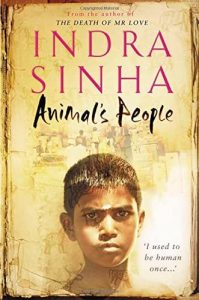Inhuman Treatment as a Way of Humanity’s Devolution into Animal:
Animal’s People and The Issue of Poverty
By Selen Kaptan

What would it be like, as a human being, to be reduced to a state of an animal by being disregarded on every possible level? Indra Sinha’s novel Animal’s People (2007) portrays a character who after a “night of terror” has lost his whole knowledge about himself including his name, family, and even his ability to stand upright. That is why he walks on all fours which leads to the children in school calling him an animal. With his not being able to recall his name, he embraces this nickname and starts calling himself Animal which suits his living conditions: he is so poor that he scavenges for food to be able to find someone’s remains of food and even chews the dry skin of his feet when he cannot find anything to feed himself. But as it turns out Animal is only one of the tens of thousands of people who got reduced to the state of an animal after being poisoned by a chemical disaster and left to their fates with the residual poison that leaked into their soil and water supplies, which have become poisonous.
In this fictional Indian town called Khaupfur, with its resources contaminated by an American-owned factory accidentally leaking poisonous gasses and killing thousands of people in a single night, not only Animal but each resident breathes, eats, and drinks poison every day. While the wind itself still carries poisonous air from the old factory and makes people deprived of their well-being, this fictional Indian government does not provide people with access to health services. With the government’s not allocating its services properly, people are pushed into the hands of poverty, and with that their hope for the future is stolen from them as they got so accustomed to the violation of their rights.
Besides that, the company that caused such a torment to these people neither agrees to decontaminate their environment nor attends the court. For eighteen years, the people of this town expect a humane approach and justice as they lost their loved ones in the accident, their health, and, along with it seems, their dignity. After years of ignoring the suffering they have caused, the lawyers of the company finally come to the town. When they stay in the best hotel, the Khaupfuris were living in “houses that look like they’ve been built by termites.” And when the lawyers even throw a party there, the people were selling their utensils to be able to feed their children in a poisonous environment that is making them sick day by day to the point that they become incapable to work. With the most fundamental needs like eating sufficiently, drinking clean water, and breathing clean air being disregarded, peoples’ lifestyles are being reduced to an animal’s and since the treatment they receive is inhuman, people of this town are being reduced to the level of an animal.
Indra Sinha’s depiction of a town like that and telling the story from Animal’s point of view emphasizes the necessity of human dignity as well as social equality and hopefully makes people realize the destruction these inhuman and degrading acts create.
